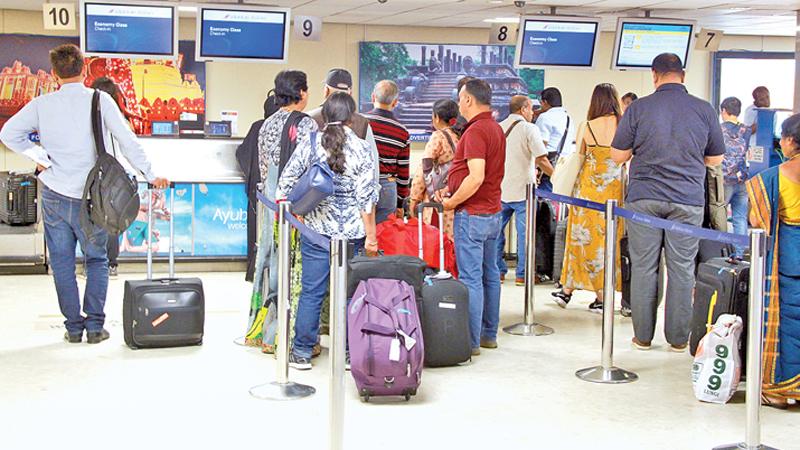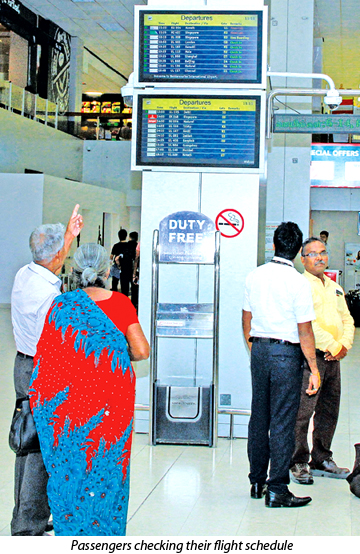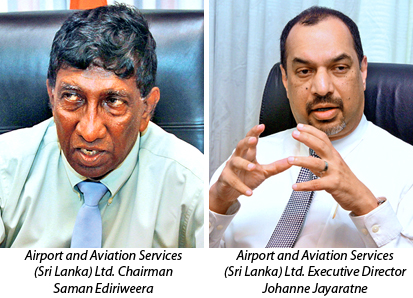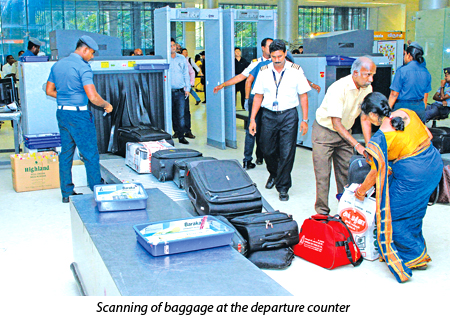
Regular visitors to Sri Lanka will soon be in for a pleasant surprise with a feeling of coming home, as plans have been firmly mooted to transform the ambience of the gateway to the country, the Bandaranaike International Airport (BIA) from the present passenger concept to a seven-star hotel ‘guest-caring’ environment, authorities in charge of operations say. The passenger terminal at Sri Lanka’s main airport will gradually see a major facelift encompassing new additions, expansions and makeovers, said an official of the airport who accompanied the Sunday Observer crew on their fact finding mission to the premises last week.
 “There is much more than what meets the eye. Often, good things go unnoticed. Patience, tolerance and concern for visitors have been the hallmark of this place,” said the Assistant Airport Manager/ Duty Manager, Wishwaka T Atalugama who greeted us as we alighted from the vehicle.
“There is much more than what meets the eye. Often, good things go unnoticed. Patience, tolerance and concern for visitors have been the hallmark of this place,” said the Assistant Airport Manager/ Duty Manager, Wishwaka T Atalugama who greeted us as we alighted from the vehicle.
The broad smile and the welcoming greeting of the staff certainly depicted the typical Sri Lankan hospitality that makes the destination stand apart from many others in the region.
However, the bustling hive of activity with vehicles lined up and the cluttering of travellers at the entrance to the departure lobby depicted the first missing link, displaying a disorganized operation that could easily be streamlined into an orderly one.
As it was the peak hour in the morning, the departing passengers were eager to get hold of trolleys, while porters, dressed in navy blue and orange waistcoats, assisted persons who approached them to unload luggage from the boots of cars and vans.
Families, friends and relatives accompanying departing passengers who wished to bid goodbye inside the lobby, eagerly lined up at the ticket counters where each ticket is said to be priced at Rs. 300.
Those departing looked tensed and panicky about getting through the first screening for safety. The atmosphere is formal and unfriendly. However, a gentle smile and a word of thanks captivated our crew who never expected a greeting of that sort.
“It’s much better than what it was. The security personnel are courteous and cooperative. I am extremely impressed,” a British traveller said.
Porters play a vital role in helping travellers to transport the luggage. This is of immense service to the feeble and the disabled travellers. However, a few onlookers said, they could sometimes be intimidating and demanding. The fee to transport a piece is Rs. 100. However, it is up to the traveller if he or she wishes, to pay extra.
The departure walkway up to the check-in lobby which is under renovation lacked adequate air conditioning. While it may have been partly due to the warm morning sunshine creeping through the high glass ceiling, this undoubtedly displeases visitors who expect a more comfortable atmosphere. Such lapses could be a deterrent to lure in visitors to the country which expects to double the number of travellers within the next five years.
The gift shops, money exchange counters and banks which had been recently shifted to the walkway proved to be a welcome change, but failed to attract some travellers who were keen to quickly pass the stretch to the lobby.
Hence, plans are afoot to add a passenger handling capacity of 2 million by building an interim terminal as a short term solution, while the construction of a new second terminal will boost capacity by a further 9 million in the long run.

‘We are coming up with our second terminal which will provide the BIA with a capacity to handle 15 million travellers at any given time,” the Assistant Airport Manager said.
He said, the current departure check-in lobby area will house additional facilities and electronic check-in counters, cafeterias and food courts, telecommunication services and money exchange services.
“The automated check-in machine placed in the lobby is very convenient and takes off the hassle of waiting in the physical check-in queue, especially, during peak hours,’ a foreign traveller who picked up his boarding pass from the machine, said.
“I don’t have any luggage with me, so with this boarding pass, I will be going straight to the immigration point,” the passenger noted.
However, The Sunday Observer team noticed that, of the four machines set up, two were non-functional.
Security
The closest scrutiny of items in luggages was made at the final security point or the passport control facing the physical check-in counters. Beyond this entry point, passengers and staff are given access to the tightly controlled airside of the airport which provides access to all areas accessible to aircraft, including runways, taxiways and apron/ramps
The safety and security, in terms of scanning and tracking explosives and other harmful devices has been tightened. Modern technology has been infused into detections to ensure least room for any unauthorized goods to get through to the flight and other destinations.
‘We have installed six scanning machines from the USA. All screening equipment meet International Civil Aviation Organization (ICAO) standards,” a security official said.
There are a considerable number of detection that take place on a daily basis, according to the officials.
However, they did not disclose all particulars of the operation for security reasons. Records on the number of detection per time period is maintained by a separate administration section, they said.
“We have 55 check-in counters and each passenger has to follow the usual screening and other documentation procedures for security clearance,” Atalugama said.

The check- in area comprises wheelchairs and staff assistance for the differently-abled. There are no buggies as are found in other international airports which can mobilize the differently-abled faster.
However, the airport operates two buggies in the peer area, the Duty Manager pointed out.
“Our aim is to complete the procedure, from the entrance to boarding the flight within 30 minutes,” Atalugama said.
However, this seems to be a tall order given the procedural requirements. A traveller said, it took him over 45 minutes at the Korean emigration.
Moving upstairs beyond the immigration point, a stark fact we observed in restaurants and duty free shops was that passengers did not have a clear knowledge about which outlets accepted local currencies and which did not, as there were no proper signboards.
“Yes, there is confusion, as certain food courts accept local currency while others accept only dollars. There is no indication as to which one accepts which currency,” said a traveller.
The maintenance of free WiFi facility, the addition of washrooms and plans for the entry of an international Duty Free operator and food courts is slated to go well for the operation of the airport and ultimately woo more visitors to the country.
Waiting to claim one’s baggage from a carousel is always a test of patience. Passengers wait standing, watching suitcases and backpacks move past in a circle until their baggage approaches.
Adverse weather generally delays the arrival of luggage by around 15-20 minutes according to the duty manager. The BIA operates six belts.
When the Sunday Observer interviewed the Executive Director of AASL, Johanne Jayaratne, he said, the objective of the revamp measures is to move from a passenger to a guest concept that would create a homely environment for both, inbound and outbound visitors. “The BIA, with the completion of the second terminal will be elevated to a seven star hotel. We want to give this experience from the time of picking up from home to boarding the flight. We are discussing with SriLankan Airlines and Sri Lanka Tourism to develop the concept,” Jayaratne said.
He assured that in future, there will be more staff engagement with guests, as Sri Lanka Tourism will play a greater role.
“We will provide music and some entertainment to keep the guests occupied so that they wouldn’t get bored. We will train the staff to provide more information to travellers and set up television screens across the terminals,” Jayaratne said.
